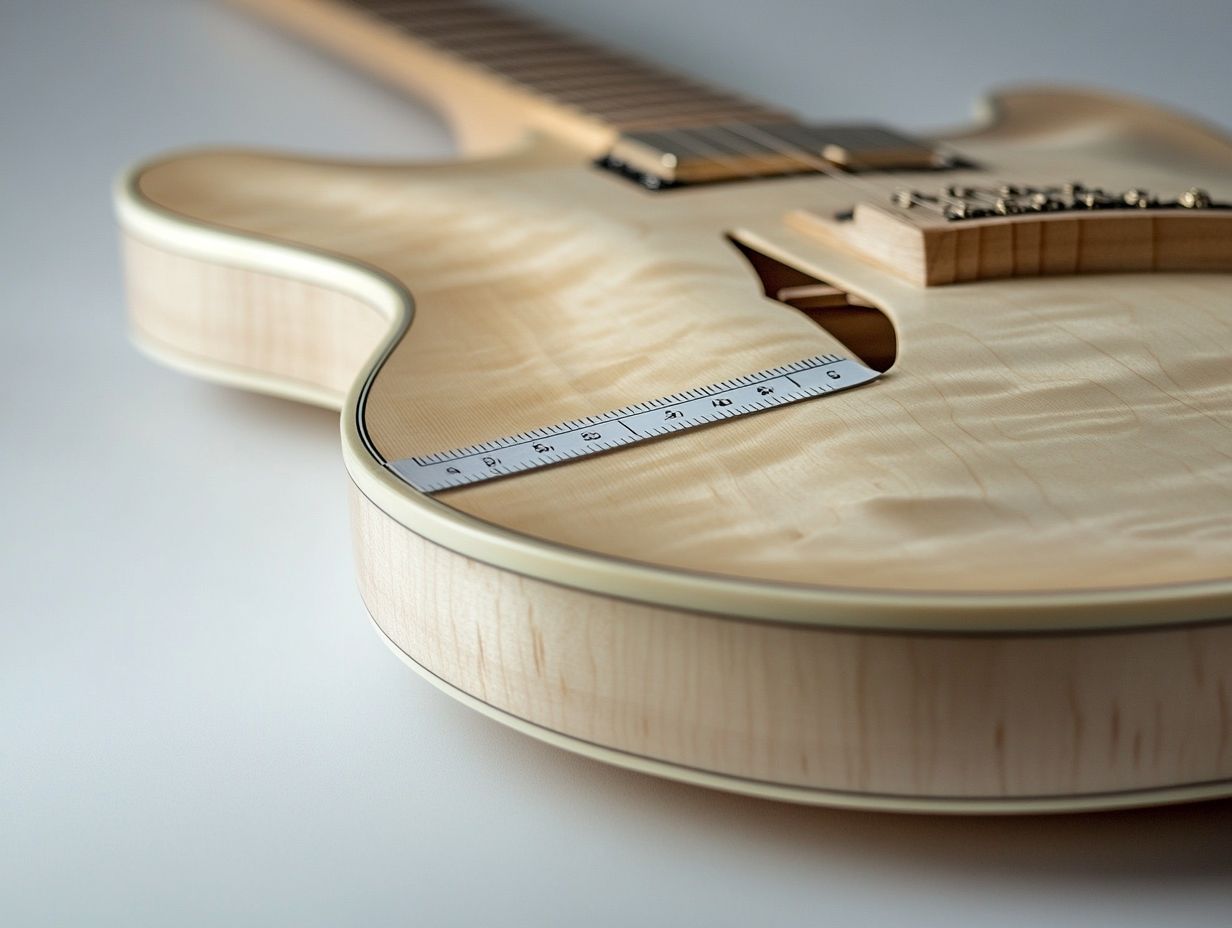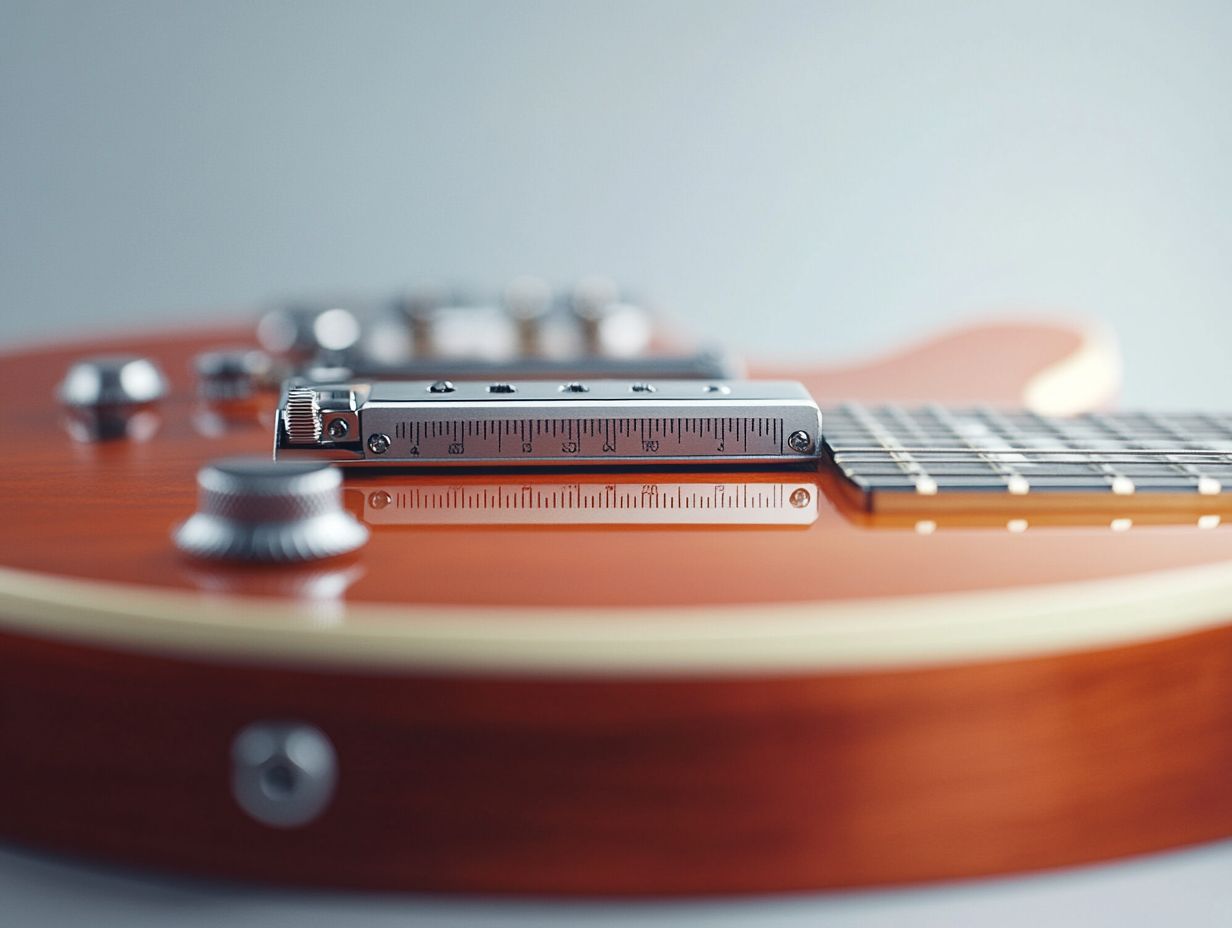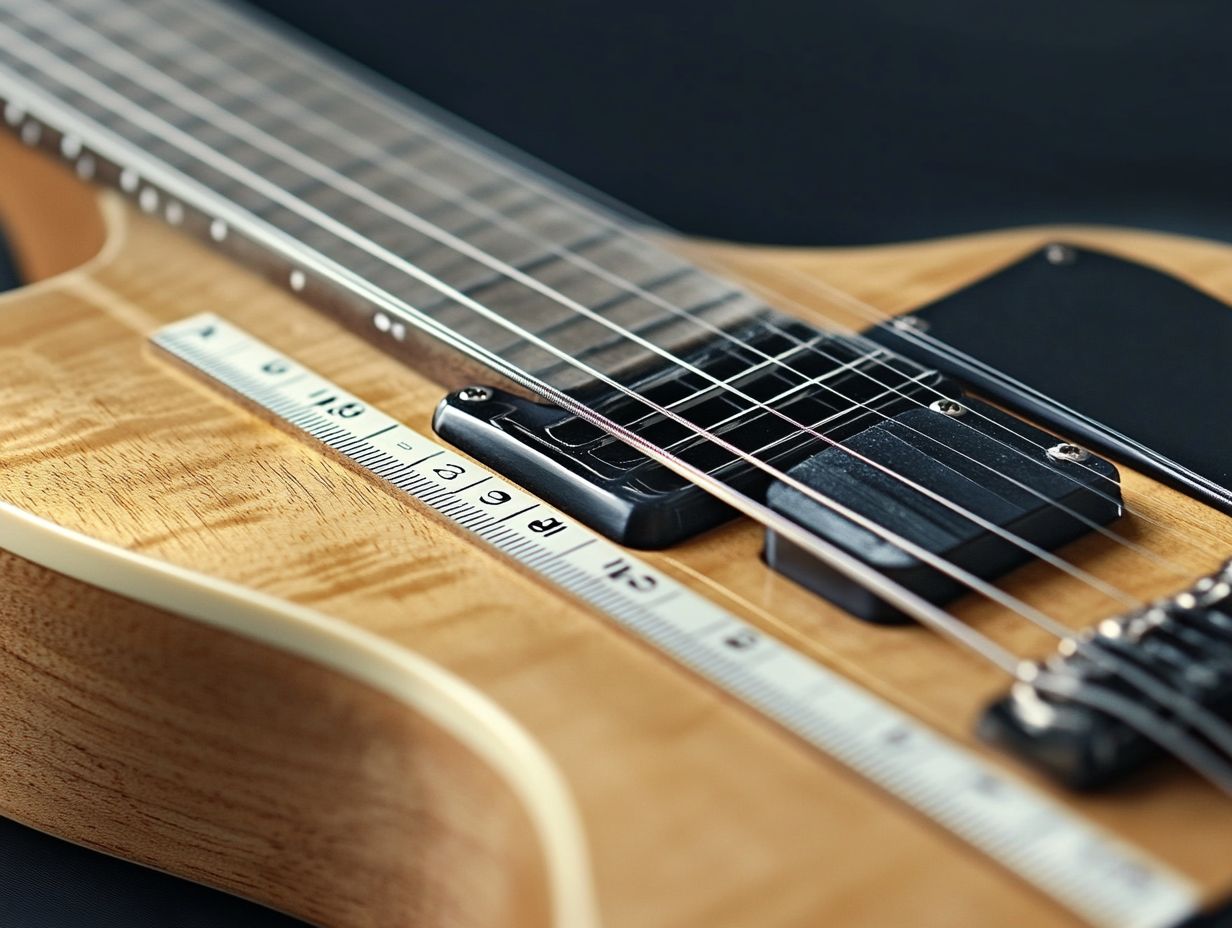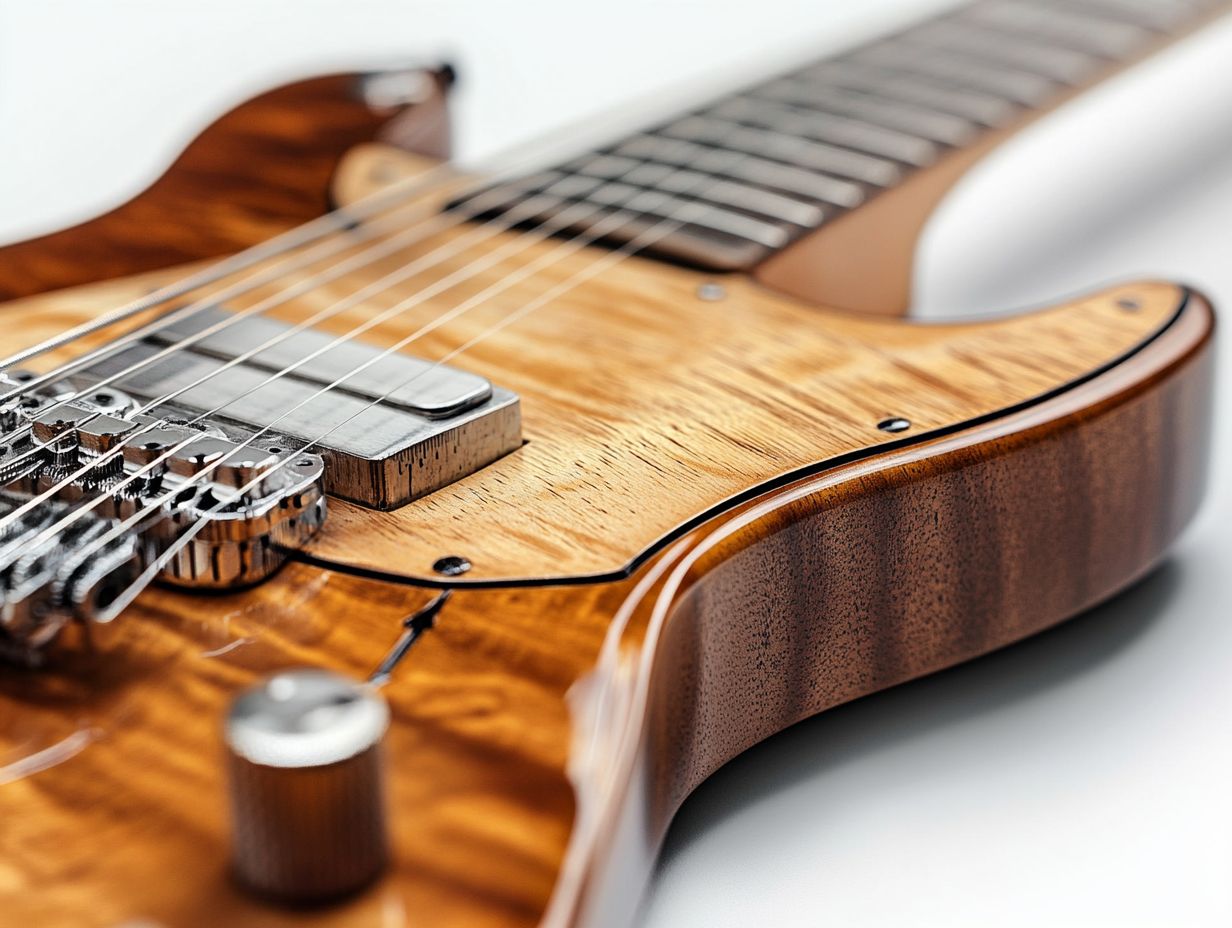The thickness of electric guitar bodies significantly influences both sound and playability. Regardless of your skill level as a musician, understanding the measurements and terminology related to guitar dimensions and electric guitar body thickness is crucial for enhancing your performance. This article will explore how guitar body size is impacted by guitar materials, design choices, and standard measurements across various styles. Additionally, we will discuss the effects of thickness on tone and playing comfort, as well as options for customizing the instrument through guitar construction techniques.
Defining Electric Guitar Body Thickness

The thickness of an electric guitar’s body is a crucial factor that influences its overall sound, playability, and aesthetics. Measurements of body thickness impact the guitar’s tone, resonance, and sustain, directly affecting sound projection and vibration transfer.
With various guitar types, including solid body, semi-hollow, and hollow body guitars, understanding the implications of body thickness is essential for both players and luthiers. Additionally, the choice of tonewoods contributes to the instrument’s acoustic properties and sound quality, making it an important consideration in the design and construction of electric guitars.
Explanation of Measurements and Terminology
Guitar body thickness is one of several measurements that describe the physical dimensions of an electric guitar. Specifically, body thickness refers to the distance from the front of the guitar to the back. This measurement varies depending on the body shape and reflects the designer’s considerations for tone, ergonomic design, and aesthetic appeal.
Alongside body thickness, other important measurements such as scale length and fretboard width also contribute to a guitar’s playability and ergonomic design, ensuring optimal weight distribution and player comfort.
These guitar dimensions influence the physical relationship between the player and the instrument, as well as the tonal characteristics produced. For instance, scale length affects string tension, which directly correlates with pitch stability and overall sound clarity. Similarly, the body contour can influence how sound waves resonate, thereby affecting the warmth and brightness of the sound.
Fretboard width is another crucial factor, as it determines the spacing available for finger placement, accommodating different playing styles and techniques. Understanding these terms and their interrelationships, including electric guitar features and ergonomic factors, enables musicians to make informed decisions when selecting an electric guitar.
Factors Affecting Body Thickness

The thickness of electric guitar bodies is influenced by the choice of body materials, design specifications, and the specifics of the guitar-making process.
The type of wood used for the body, such as mahogany body, maple body, or poplar body, impacts not only the guitar’s appearance and resale value but also its acoustic properties and tonal balance.
Additionally, the level of craftsmanship and the manufacturing process play a crucial role in determining body thickness, which subsequently affects sound projection and player preference for different music genres.
Materials and Design Considerations
The materials and design considerations of electric guitars significantly influence body thickness and play a crucial role in the instrument’s overall sound quality, aesthetic appeal, and durability.
Selecting the right tonewood is essential for achieving the desired acoustic properties, as different types of wood contribute unique tonal characteristics that affect resonance and sustain.
Additionally, the ergonomic design of the guitar, which includes aspects such as weight distribution and body contour, can dictate body thickness to enhance playing comfort and performance quality for various music genres, ensuring the instrument’s balance and player comfort.
For instance, mahogany is renowned for its warm, rich tones, while ash provides a brighter sound with excellent clarity.
The interplay between body thickness and the type of tonewood used can create diverse sound dynamics and sound characteristics, catering to the preferences of players across genres, from jazz to rock.
Durability is another important factor that designers consider when determining body depth and body width, ensuring that the guitar can withstand the demands of performance and transportation.
Alongside features like cutaways and contours, these elements not only enhance playability but also contribute to the instrument’s ability to resonate beautifully, making them vital for producing quality sound and achieving desired tonal differences.
Standard Thickness for Electric Guitar Bodies

The standard thickness of electric guitar bodies varies depending on the electric guitar types, with typical measurements ranging from 1.5 to 2 inches for solid body guitars. This thickness is significant as it affects the guitar’s sound quality, tonal range, and overall playability.
In contrast, semi-hollow and hollow body guitars may have different thicknesses, which can impact the instrument’s acoustic feedback and body resonance. These factors play a crucial role in shaping the musician’s toolkit for various music genres.
Common Measurements for Different Styles
Electric guitar styles typically exhibit a wide variation in dimensions, including body outline, scale length, and fret count. For instance, solid body electric guitars have a thinner profile, whereas hollow body guitars have greater body depth to enhance sound projection and acoustic feedback.
Understanding these guitar dimensions is essential for players seeking an instrument that aligns with their playing style, preferences, and desired tonal characteristics, ensuring compatibility with different music genres.
Another crucial aspect to consider is scale length, which significantly influences string tension and playability. Generally, shorter scale lengths facilitate note bending, making genre-specific guitars for blues and rock more favorable, while longer scales tend to produce fuller and brighter sounds with a more pronounced response.
String gauge also plays an important role; lighter gauges enhance speed and make fretting easier, while heavier gauges provide sustained tones and fuller sounds. These combined measurements, including fretboard dimensions and neck joint considerations, enable guitarists to choose an instrument that best complements their unique musical style.
Effects of Body Thickness on Sound and Playability

The thickness of an electric guitar body significantly influences both sound and playability, affecting the instrument’s tone and its suitability for various genres, playing a pivotal role in the electric guitar market.
Thicker bodies enhance sustain and resonance, enabling sound waves to travel more fully, while thinner bodies facilitate easier playability and handling.
Players should take these factors into account when selecting a guitar, as they can greatly impact overall performance and user comfort.
How Thickness Impacts Tone and Comfort
The thickness of an electric guitar body plays a significant role in tone shaping and ergonomic design, ultimately influencing how musicians experience their instrument during performances, affecting player preference and performance attributes.
A well-designed ergonomic guitar, taking body thickness into account, can enhance playability by providing comfortable access to frets and strings.
While guitar accessories and modifications can improve the guitar playing experience by accommodating individual preferences, it is essential for both players and luthiers to understand the fundamental relationship between body thickness and tone. This relationship is crucial for how the instrument resonates, affecting various aspects from volume to sonic profile.
Thicker bodies may produce a stronger low-end response, whereas thinner bodies often yield brighter tones and offer increased ease of handling. These variations in body thickness can also impact the musician’s posture and grip, which is particularly important during long practice sessions or performances, ensuring sound response and user comfort.
Exploring modifications such as contouring or adjusting the neck angle can lead to significant improvements in comfort and tone for those looking to personalize their guitars, enhancing the electric guitar anatomy and performance quality.
Customizing Body Thickness
Adjusting the body thickness of a guitar is a common modification for musicians looking to personalize their instruments and enhance their music genre compatibility and playing experience.
This adjustment can also improve the guitar’s sound and user comfort. User manuals and various learning resources offer guidance on how to make these modifications without compromising the artistry or craftsmanship standards of the instrument.
Options for Personalization and Modification
Players have several options for customizing and modifying electric guitars to achieve their preferred body thickness. These modifications may include altering the body contour and utilizing guitar accessories that tailor the instrument to the musician’s playing style and comfort. Setup guides and tutorials assist players in understanding the correct methods for customizing their instruments, ensuring that they achieve the desired thickness without compromising sound quality or build quality.
Body thickness can significantly impact playability; thicker bodies often provide a warmer tone and better sustain, while thinner designs facilitate easier handling and quicker playability. Musicians may choose to change pickup configuration or apply custom finish options to further enhance their unique sound and aesthetic.
Accessories such as strap locks, modified bridges, and customized fretboards can also play a crucial role in achieving the feel and performance they desire. By consulting setup guides, players can obtain tailored recommendations that meet their individual needs, transforming an off-the-shelf instrument into a customized masterpiece, enhancing instrument craftsmanship and luthier craftsmanship.



